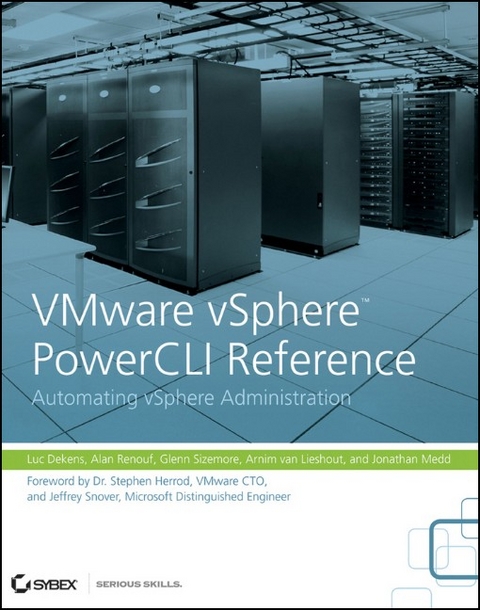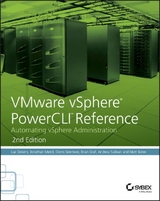
VMware VSphere PowerCLI Reference
John Wiley & Sons Ltd (Verlag)
978-0-470-89079-0 (ISBN)
- Titel erscheint in neuer Auflage
- Artikel merken
Your One-Stop Reference for VMware vSphere Automation If you manage vSphere in a Windows environment, automating routine tasks can save you time and increase efficiency. VMware vSphere PowerCLI is a set of pre-built commands based on Windows PowerShell that is designed to help you automate vSphere processes involving virtual machines, datacenters, storage, networks, and more. This detailed guide using a practical, task-based approach and real-world examples shows you how to get the most out of PowerCLI's handy cmdlets. Learn how to: * Automate vCenter Server and ESX/ESX(i) Server deployment and configuration * Create and configure virtual machines and use vApps * Secure, back up, and restore your virtual machines * Monitor, audit, and report the status of your vSphere environment * Use the PowerCLI SDK, PowerWF Studio, and vEcoShell * Schedule and view automation * Add a GUI front end to your scripts
Luc Dekens, VMware vExpert, has worked with operating systems for over 20 years and now focuses on virtualization, particularly platforms produced by VMware. He blogs about PowerCLI and the vSphere SDK at www.lucd.info. Alan Renouf, VMware vExpert, is an EMC vSpecialist and has been working with VMware, Citrix, and Microsoft products for several years. Currently he focuses on virtualization products and their automation using PowerShell. He is also cohost, along with Jonathan Medd, of the Get Scripting podcast (www.get-scripting.blogspot.com). Glenn Sizemore, VMware vExpert, started scripting early in his IT career, adopting PowerShell early on and conquering it when VMware PowerCLI first shipped. He shares scripts and automation techniques on his blog at www.Get-Admin.com. Arnim van Lieshout, VMware vExpert, has been in the IT industry for 12 years, working mainly with operating systems. He has been focusing on virtualization for the last five years, especially automating tasks using PowerShell. Arnim blogs at www.van-lieshout.com. Jonathan Medd, PowerShell MVP, is cohost of the Get-Scripting podcast and also shares his PowerShell knowledge at www.jonathanmedd.net.
Forewords xix Introduction xxi Part I Install, Configure, and Manage the vSphere Environment 1 Chapter 1 Automating vCenter Server Deployment and Configuration 3 Prepare the vCenter Installation 4 Create an Automated Installation 5 Set Up Your vCenter Folder Structure 8 Creating a Folder Structure from Scratch 8 Exporting a Folder Structure 11 Importing a Folder Structure 14 Define Users and Their Privileges 15 Granting Privileges 15 Creating New Roles 19 Bringing in Users 21 Exporting Permissions 22 Importing Permissions 24 Configure Datacenters and Clusters 26 Creating Datacenters 27 Creating Clusters 27 Configuring High Availability 27 Configuring Distributed Resource Scheduler 28 Configuring Enhanced vMotion Compatibility 29 Configuring Distributed Power Management 29 Licensing 31 Viewing License Information 31 Licensing a Host 33 Chapter 2 Automating vSphere Hypervisor Deployment and Configuration 35 Prepare for an Installation 36 The Installation Medium 36 Gathering Required Software 37 Automate an Installation 37 Customizing an Installation with Kickstart 38 Postinstallation Configuration 43 Chapter 3 Automating Storage and Networking 67 Set Up the Storage 68 Setting Up Different Types of Storage 68 Configuring an iSCSI Target 69 Rescanning for New Storage 70 Adding Datastores 70 Setting a Multipath Policy 77 Set Up the Network 78 Standard and Distributed Switches 78 Adding VMkernel Port Groups 83 Making Your Switches and Port Groups Resilient 84 Copying Networking Configuration from Another Host 86 Moving Multiple VMs to a New Port Group 89 Chapter 4 Using Advanced vSphere Features 93 Manage vNetwork Distributed Switches 94 Use Fault Tolerance 105 Configure Storage I/O Control 106 Use Distributed Power Management 113 Configure Host Profiles 117 Configure Active Directory Integration 120 Part II Managing the Virtual Machine Life Cycle 127 Chapter 5 Creating Virtual Machines 129 Use the New-VM Cmdlet 130 Creating a New Virtual Machine 131 Cloning a Virtual Machine 136 Deploying from a Template 137 Registering a Virtual Machine 139 Use the SDK 143 Perform a Mass Deployment 150 Preparing for Mass Deployment 151 Running the Deployment Synchronous or Asynchronous 152 Postconfiguration and Validating the New Virtual Machines 154 Identify Eye-Catchers for Auditing 157 Using Custom Attributes 157 Maintaining Custom Attributes 159 Maintain VMware Tools 163 Windows Silent Install 164 Linux Silent Install 165 Updating VMware Tools 170 Chapter 6 Using Templates and Customization Specifications 173 Use Customization Specifications 174 Creating Customization Specifications 174 Managing Customization Specifications 175 Using Customization Specifications 177 Use Templates 178 Creating Templates 178 Deploying Guests from Templates 179 Maintaining Templates 185 Chapter 7 Configuring Virtual Machine Hardware 197 Add, Configure, and Remove Virtual Hardware 198 Changing Virtual Memory 198 Changing Memory Resources 199 Changing the Number of vCPUs 201 Changing vCPU Resources 203 Adding or Removing a Network Adapter 205 Assigning a Network 207 Adding a Virtual Disk . 208 Removing a Virtual Disk 211 Extending a Virtual Disk 218 Changing Other Hardware 221 Optimize Storage Usage with Thin Provisioning 223 Converting a Virtual Disk Using Storage vMotion 224 Converting a Virtual Disk in Place 224 Chapter 8 Advanced Virtual Machine Features 229 Interact with the Guest OS 230 Using Linux Native Tools 231 Using Windows Native Tools 235 Using PowerCLI Methods 245 Use vMotion and Storage vMotion 250 Examining vMotion Requirements 250 Moving a Virtual Machine 251 Use and Manage Snapshots 256 Creating and Removing Snapshots 257 Maintaining Snapshots 258 Restricting the Creation of Snapshots 264 Chapter 9 Using vApps 269 Import Virtual Appliances 270 Create Your Own vApps 272 Maintain vApps 274 Setting the Start Order 274 Using IP Pools 282 Using IP Assignment 293 Modifying vApp Product Information 296 Part III Securing Your vSphere Environment 301 Chapter 10 Backing Up and Restoring Your Virtual Machines 303 Work with Snapshots 304 Create Do-It-Yourself Backups 304 Restore Your VMs from a DIY Backup 307 Change Block Tracking 308 Checking CBT Status 309 Enabling/Disabling CBT 309 Use Site Recovery Manager 311 Automating SRM Using PowerShell Functions 311 Customizing Recovery Plans 312 Provide PowerShell Support for Corporate Backup Applications 315 Quest 316 Veeam 320 Chapter 11 Organize Your Disaster Recovery 325 Back Up Your vCenter Server 326 Backing Up Your vCenter Server Database 327 Backing Up Your vCenter Server Configuration 333 Restore Your vCenter Server 336 The Restore Sequence 336 Restoring Your vCenter Server Database 337 Reconnecting ESX Hosts 340 Export vCenter Server Inventory Items 344 Folders 345 Datacenters 347 Clusters 349 Roles 350 Permissions 351 VM Locations 352 Hosts 352 Import vCenter Server Inventory Items 353 Folders and Datacenters 353 Datacenter Folders 354 Clusters 355 Hosts 356 VM Locations 357 Roles 358 Permissions 358 Recover Virtual Machines 360 Chapter 12 Hardening the vSphere Environment 367 Use the Hardening Guide 368 Work with the Guidelines 369 Virtual Machines 369 ESX(i) Hosts 375 vNetwork 394 vCenter Server 399 COS 399 Bring It All Together 401 Chapter 13 Maintain Security in Your vSphere Environment 403 Install the vCenter Update Manager PowerCLI Snap-in 404 Work with Baselines 406 Creating a Baseline 406 Updating a Baseline 410 Attaching and Detaching Baselines 411 Work with Upgrades and Patches 412 Scanning a Host 412 Staging Patches to a Host 413 Remediating a Host 414 Including Patching as Part of Host Deployment 416 Countering the Self-Aware Update Manager 417 Report the Security Status 419 Understanding Datacenter Compliance 419 Implementing Specific Baseline Compliance 422 Implementing Required Patches 424 Part IV Monitoring and Reporting 427 Chapter 14 Reporting the Status of Your vSphere Environment 429 Determine What to Report 430 Virtual Machines 430 Guest Operating Systems 436 Hosts 438 Clusters 445 Customize Your Reports 450 Adding Properties to Existing Objects 450 Creating Custom Objects 452 Exporting Output 453 Chapter 15 Using Statistical Data 463 Understand Some Basic Concepts 464 What Does vCenter Server Add? 464 Historical Intervals 468 Statistics Levels 470 Metrics 473 Instances 479 Gather Statistical Data 482 The Cmdlets 483 What Is in the Statistical Data? 483 Know Which Metrics to Use 485 Techniques 486 Offload Statistical Data 499 Chapter 16 Monitoring the vSphere Environment 501 Determine What to Monitor 502 Use Alarms 503 Designing an Alarm 503 Removing Alarms 524 Modifying Alarms 525 Moving Alarms 526 Chapter 17 Auditing the vSphere Environment 529 Understand Tasks and Events Data 530 Report the PowerCLI Way 535 What Does Get-VIEvent Return? 535 Using the Get-VIEvent Cmdlet 537 Report the SDK Way 543 Why Use the SDK API? 544 What Is a Collector? 544 Fitting Collectors into Your Script 544 Sample Scripts 551 Configure Tasks and Events Retention 554 Part V Scripting Tools and Features 561 Chapter 18 Scheduling Automation Scripts 563 Use the vCenter Server Scheduler 564 Creating vCenter Server Scheduled Tasks 564 Reporting on vCenter Server Scheduled Tasks 567 Use the Windows Scheduler 569 Scheduling Scripts on Windows 570 Dealing with PowerCLI Issues When Scheduling Scripts 571 Working with the Scheduled Tasks Module 576 Chapter 19 The SDK 583 Work with the vSphere SDK 584 Use the vSphere API Reference 586 Setting a Host in Maintenance Mode 588 Did the Alarm Fire the SNMP Trap? 589 Finding Metrics for Thin Provisioning 590 Can You Migrate This Guest? 592 Use Managed Objects 596 Managed Object Types 597 Data Objects and Their Methods 600 Using vSphere Managers 603 Managed Object References 605 Code Parameter Objects 609 Find the Method You Need 610 Changing the Boot Delay of a Virtual Machine 611 Finding the Patches Installed on an ESX Host 612 Finding the Host HWuptime 613 Changing the vCenter Logging Options 614 Understand Return Values and Faults 615 Put Some Tips and Tricks to Good Use 618 Waiting for an Asynchronous Task 618 Better Error Handling after Asynchronous Tasks 619 Finding Service Managers with Get-View Shortcuts 619 Chapter 20 The Onyx Project 621 Work with the Onyx Project 622 Let Onyx Help You 622 Use Onyx 623 Connecting to a vCenter or an ESX(i) Server 623 Translating Captured SOAP Traffic 626 Configuring Onyx 626 Using Onyx Output 630 Work with References 632 Hard-Coded References to Entities 633 Hard-Coded MoRefs 633 Use Onyx in the Real World 633 Chapter 21 PowerGUI and vEcoShell 635 Understand GUI Environments in Managing Automation 636 Use PowerPacks to Manage Automation Scripts 637 Making a Connection to vCenter Server 639 Working with Links and Actions 642 Using the VMware PowerPack for Reporting 646 Using the VMware PowerPack for Administration Tasks 650 Importing the VMware Community PowerPack 653 Creating a PowerPack 658 Chapter 22 PowerWF Studio 663 Understand PowerWF Studio s Capabilities 664 Integrate PowerWF Studio 665 Use PowerCLI in PowerWF Studio 665 Graphical Flow 666 Script Editor 667 Use a Workflow 668 Create Typical Workflows 671 Creating New Guests from the DOS Prompt 671 Creating a Log Viewer Using PowerWF Studio 675 Register-VMX as a Windows Application 682 Bringing It All Together 683 Chapter 23 Add a GUI Front-End to Your Automation Scripts 687 Appreciate the Value of a GUI 688 Choose the Correct Tool 688 Create Some Basic WinForms 690 The Form Modes 691 Adding a Control 692 Using a Script Layout Template 695 Adding List Boxes 697 Adding Radio Buttons 701 Create a Somewhat Advanced Example 704 Index 715
| Zusatzinfo | Illustrations |
|---|---|
| Verlagsort | Chichester |
| Sprache | englisch |
| Maße | 187 x 235 mm |
| Gewicht | 1154 g |
| Themenwelt | Mathematik / Informatik ► Informatik ► Betriebssysteme / Server |
| Informatik ► Office Programme ► Outlook | |
| ISBN-10 | 0-470-89079-7 / 0470890797 |
| ISBN-13 | 978-0-470-89079-0 / 9780470890790 |
| Zustand | Neuware |
| Haben Sie eine Frage zum Produkt? |
aus dem Bereich



